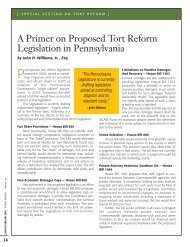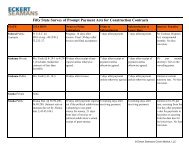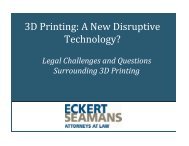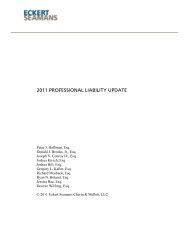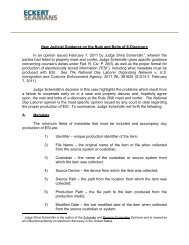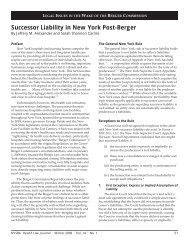foreclose all challenges against that first complaint. Finally, the Superior Court held thatequitable considerations did not require that the judgment of non pros be opened and that thetrial court had not abused its discretion in refusing to do so. The court noted that while Womerv. Hilliker, 908 A.2d 269 (Pa. 2006), had held that Rule 1042.3 is subject to equitableconsiderations, Rule 126 applied only where a plaintiff had substantially complied with Rule1042.3, not where a plaintiff had failed entirely to file a certificate of merit. Therefore, in thiscase Rule 126 did not apply. Moreover, when the case was evaluated under Rule 3051,Plaintiff’s argument failed because the reasons she offered for not having filed the certificate didnot constitute a reasonable excuse. Consequently, the decision of the trial court was affirmed.The Pennsylvania Supreme Court had granted appeal limited to the issues of 1) whether acertificate of merit must be filed within sixty days of the filing of the original complaint,notwithstanding the filing of preliminary objections and/or an amended complaint and 2)whether the complaint and amended complaint raise a professional negligence claim whichrequires the filing of a certificate of merit. As indicated above, the Supreme Court affirmedthe Superior Court, doing so by per curiam order, over the dissent of one Justice.On December 19, 2007, in light of the Supreme Court’s comment in a footnote inWomer, 908 A.2d 269 n.10, in a non-precedential, unpublished opinion the Harris court reversedits 2005 decision and remanded back to the trial court for the entry of judgments of non pros infavor of appellants, Jefferson, Weiss, and Neuburger.Previously, in Harris, 877 A.2d 1275, the Superior Court held that the trial court had notabused its discretion in opening judgments of non pros where Plaintiff had not filed certificatesof merit within sixty days of filing a medical malpractice complaint, but had, in that time period,provided Defendants with actual expert reports and CV’s. Despite having received these expertreports, which did state that Defendants had deviated from the standard of care and that suchdeviations caused Plaintiff harm, the appellants Jefferson, Weiss, and Neuburger filed praecipesfor non pros, on the basis of which judgment had been entered in their favor in accordance withRule 1042.6. However, appellant Childers failed to seek a judgment of non pros at that time.Plaintiff petitioned to have the judgments opened, arguing substantial compliance with Rule1042.3(a). The trial court granted the petition.On initial appeal, the Superior Court in its 2005 opinion held that this was proper becausethe underlying purpose of Rule 1042.3 was to prevent the filing of baseless medical malpracticeclaims and plaintiff had satisfied this purpose by supplying the actual expert reports. The courtfurther stated that Plaintiff had reasonably explained the lack of technical compliance with Rule1042.3 in that it was not unreasonable for him to believe that his actions constituted substantialcompliance with the Rule. Given the facts of the case, the Superior Court concluded, he shouldnot be barred from his day in court. Accordingly, the Superior Court relinquished jurisdictionand the matter was returned to the trial court.Following the Supreme Court’s decision in Womer, appellants filed motions in trial courtfor reconsideration of the earlier decision to open the judgment of non pros. In denying thesemotions, the trial court indicated that it was unable to entertain such motions based upon theSuperior Court’s earlier decision. Appellants filed interlocutory appeals.118
Relying on the language of Womer, the Superior Court on December 19, 2007 reversedits earlier decision and remanded the case to the trial court for the entry of judgments of non prosin favor of appellants Jefferson, Weiss, and Neuburger. However, with regard to appellantChilders, the Superior Court remanded the case back to the trial court for reconsideration of itsdecision to deny the judgment of non pros. The Superior Court explained that Childers failed toseek a judgment of non pros until after plaintiff filed a certificate of merit and after a great dealof time had been spent litigating the case. Therefore, the Court reasoned, “[t]here is not the total‘non-compliance’ that was present in Womer, and there are undeniable equities to be evaluatedby the fact finder in considering whether a judgment of non pros is warranted and equitable.”Interestingly, in a footnote, the Court in its December 2007 Opinion states: “[a] decisionby this court to stubbornly adhere to a precedent that has since been disapproved by the highestCourt in the Commonwealth, would merely delay the inevitable reversal of this Court’s decisionby the Supreme Court.”In Weaver v. University of Pittsburgh Medical Center, No. 08-411, 2009 U.S. Dist.LEXIS 57988 (W.D. Pa. July 30, 2008), the District Court examined whether Plaintiffsubstantially complied with the certificate of merit requirement. Defendant filed a Motion toDismiss, arguing Plaintiff’s corporate negligence claim should be dismissed because Plaintiff’scertificate of merit only supported a claim of vicarious liability against the hospital and not adirect claim of corporate negligence. Plaintiff conceded the certificate of merit only containedlanguage supporting a claim of vicarious liability, but claimed she simply checked the wrong boxwhen completing the certificate of merit.Plaintiff made several arguments why the court should not dismiss Plaintiff’s corporatenegligence claim. Plaintiff argued in light of the language of the Complaint that only set forth aclaim of corporate negligence (and not vicarious liability), Plaintiff’s incorrect certificate ofmerit was simply a procedural mistake. Plaintiff also produced the opinion of an expert that wasdated prior to the filing of the certificate of merit, which supported Plaintiff’s direct claim ofcorporate negligence and did not support a claim of vicarious liability. Finally, Plaintiff arguedthat since the statute of limitations had not run, the Complaint could simply be re-filed and thatthe re-filing of the Complaint would cause unnecessary paper shuffling.Plaintiff relied heavily on the recent opinion in Stroud, 546 F. Supp. 2d 238, wherecounsel for Plaintiff checked the vicarious liability box on the certificate of merit, not the box forcorporate liability. The court distinguished Stroud, noting the Plaintiff in Stroud could not re-filethe Complaint with a proper certificate of merit because the statute of limitations had run, butthat in the present case Plaintiff was able to re-file a new Complaint with a proper certificate ofmerit. The court also explained that in Stroud, Plaintiff failed to check both applicable boxes onthe certificate of merit (only checking box for vicarious liability); however, in the present case,Plaintiff checked the wrong box, which is clearly supported by Plaintiff’s Complaint and expertreport. The court noted “[w]hile the certificate of merit filed by Plaintiff’s counsel may reflectan egregious lack of attention to detail or knowledge of Pennsylvania law, we conclude Plaintiffhas substantially complied with Rule 1042.” Thus, the court held the filing of an impropercertificate of merit was excusable when counsel simply checked the wrong box (not the wrong119
- Page 3 and 4:
EMTALA CASES ......................
- Page 5:
Filing an Affidavit of Non-Involvem
- Page 8 and 9:
II.PROFESSIONAL LIABILITY - AN OVER
- Page 10 and 11:
The Superior Court reversed the tri
- Page 12 and 13:
to a third party pursuant to the st
- Page 14 and 15:
After approximately five months, De
- Page 16 and 17:
learned the day after the surgery t
- Page 18 and 19:
conduct to the delay in colon cance
- Page 20 and 21:
court admitted the expert’s testi
- Page 22 and 23:
(b)(c)other reasonable causes, incl
- Page 24 and 25:
corroborated his testimony. The cou
- Page 26 and 27:
husband’s estate. Plaintiff alleg
- Page 28 and 29:
Other notable federal cases arising
- Page 30 and 31:
The Superior Court found that in re
- Page 32 and 33:
§ 1303.512(b). The court, however,
- Page 34 and 35:
In Neidig v. United States, No. 07-
- Page 36 and 37:
Additionally, the Supreme Court not
- Page 38 and 39:
were not indicated for her conditio
- Page 40 and 41:
surgeon is the same as it would be
- Page 42 and 43:
It should be noted that the Superio
- Page 44 and 45:
Finally, the court held that the tr
- Page 46 and 47:
The Supreme Court of Pennsylvania r
- Page 48 and 49:
nurses deviating from applicable st
- Page 50 and 51:
certainty, the court reviews expert
- Page 52 and 53:
Under Pennsylvania law, the Court n
- Page 54 and 55:
testimony, Defendant presented his
- Page 56 and 57:
Following Cooper v. Roberts, 286 A.
- Page 58 and 59:
Plaintiff developed chronic diarrhe
- Page 60 and 61:
where payment is made by Medicaid w
- Page 62 and 63:
accomplished. In Valles v. Albert E
- Page 64 and 65:
In 1980, the Pennsylvania Superior
- Page 66 and 67:
Plaintiff had a routine monitoring
- Page 68 and 69:
Plaintiff’s Contract ClaimsThe Co
- Page 70 and 71:
is a failure to report changes in a
- Page 72 and 73:
unit to assure post-surgical patien
- Page 74 and 75: sliced his wrist and arm with a raz
- Page 76 and 77: licensed professionals for whom the
- Page 78 and 79: (c)Limitations of Corporate Neglige
- Page 80 and 81: Even more recently, our Superior Co
- Page 82 and 83: (a)HMO IssuesIn McClellan v. Health
- Page 84 and 85: affidavit submitted by Defendants o
- Page 86 and 87: treatments while at VA’s faciliti
- Page 88 and 89: [s]ubstantively, we believe that a
- Page 90 and 91: The party claiming the benefit of t
- Page 92 and 93: deprive (him) of civil rights guara
- Page 94 and 95: found that the District Court was w
- Page 96 and 97: With respect to fraudulent concealm
- Page 98 and 99: would be applied in situations wher
- Page 100 and 101: they had not raised them in the cou
- Page 102 and 103: (a)Informed ConsentUnder MCARE, a p
- Page 104 and 105: civil enforcement provisions and ma
- Page 106 and 107: MCARE also changes the manner in wh
- Page 108 and 109: whose death, in 2005, was allegedly
- Page 110 and 111: vicariously liable if the plaintiff
- Page 112 and 113: health center or its equivalent or
- Page 114 and 115: In Pennsylvania Medical Society, th
- Page 116 and 117: to any professional who is alleged
- Page 118 and 119: Since the 2005 amendments, there ha
- Page 120 and 121: ule, but who intentionally ignores
- Page 122 and 123: the original Complaint was delivere
- Page 126 and 127: number of boxes), which was support
- Page 128 and 129: questions of professional judgment
- Page 130 and 131: deviated from any professional stan
- Page 132 and 133: The Third Circuit affirmed the Dist
- Page 134 and 135: claims and cross-claims remain agai
- Page 136 and 137: By an Amendatory Order dated March
- Page 138 and 139: The court acknowledged that there i
- Page 140 and 141: apply and that the trial court misa
- Page 142 and 143: Barbados had enough litigation-spec
- Page 144 and 145: E. Preemption of Vaccine Design Def
- Page 146 and 147: 2. Pa. R. Civ. Pro. 1036.1 - Reinst
- Page 148 and 149: Barrick, at *34-35.Furthermore, the
- Page 150 and 151: (b) the utility of the defendant’
- Page 152 and 153: 2006). In this case, Plaintiffs bro
- Page 154 and 155: B. Elements of a Cause of Action fo
- Page 156 and 157: decision in Muhammad precluded Mr.
- Page 158 and 159: considered speculative “only if t
- Page 160 and 161: underlying cause of action involved
- Page 162 and 163: In Capital Care Corp., the Superior
- Page 164 and 165: The court found, however, to state
- Page 166 and 167: of reasonable diligence. The standa
- Page 168 and 169: not be set aside. On July 7, 2005,
- Page 170 and 171: complete bar to recovery. Since a l
- Page 172 and 173: On appeal, Plaintiffs claimed that
- Page 174 and 175:
In Liggon-Redding, 659 F.3d at 265,
- Page 176 and 177:
elieved of those minimum standards
- Page 178 and 179:
elevant to the proceedings, the com
- Page 180 and 181:
establish professional misconduct b
- Page 182 and 183:
Upholding the Superior Court’s Or
- Page 184 and 185:
Id.Rejecting revocation and suspens
- Page 186 and 187:
order as a sanction under Rule 4019
- Page 188:
{1009912]182



